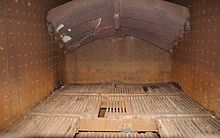Fire box

The fire box is designed as a large suitcase-like space within the standing boiler of steam locomotives and serves as a combustion chamber. In older designs it consists of three parts: fire box jacket, pipe wall and rear wall. The fire box roof is often inclined backwards so that it remains covered even when the water level is low.
The fire box is connected to the standing boiler using stud bolts so that it is surrounded on all sides by water. The water space should be kept wide so that the steam bubbles can flow upwards and new water to be evaporated can flow in unhindered.
The fire box is closed off at the bottom by the grate, which carries the fuel and serves to supply air to the combustion chamber and at the same time ensures the separation of ashes and slag. The connection between the fire box and the outer shell of the rear boiler is made by the bottom ring, which also forms the lower end of the water space and to which the support bars of the grate are attached. The ash box is also attached under the bottom ring .
The grate was designed largely according to the choice of fuels used or the performance of the locomotive; the type of fuel determined the strength of the grate bars and the spaces between them. Garbe described the ideal fire box as long and narrow for as perfect a combustion as possible. On the other hand, the grate could not be extended arbitrarily with manual firing, here 3 m was considered a reasonable size. A higher evaporation heating surface, in turn, required a larger heating and thus grate surface. However, a heater could be expected to handle a maximum of 4.5 m² with manual firing ( DR series 45 ). Locomotives with a larger grate area appeared at the same time with a stoker ( SŽD series ФД with 7.04 m² grate area). The largest known grate area is known for the UP class 4000 with 13.97 m².
Most of the grates were designed as folding grates, on the one hand to make it easier to purify the grate and, on the other hand, to enable purification in train stations on the way, even on difficult cross-country trips.
In addition, many boilers have a flat-arched fire screen made of refractory bricks or refractory mortar in the front area of the fire box. This protects the pipe wall from excessive heat, serves as a heat store and also ensures that the combustion air and the heating gases are swirled, so that fresh fuel can be heated and ignited more quickly. The fire hole is located in the rear wall of the fire box, which is closed by the fire door.
Newer boilers often still contain the combustion chamber , which connects to the fire box. In this case, the pipe wall is laid further into the long boiler so that the radiant heating surface (and thus the effectiveness of the boiler) is increased.
When steam locomotives are operated with liquid fuels such as heavy oil, there is no grate in the fire box, the combustion chamber is formed by the ash box and the actual fire box. Since the oil fire (1,600 ° C) generated by the burners generates a very high level of radiant heat, the ash box and large parts of the actual fire box must be lined with firebricks.
literature
- Author collective Johannes Schwarze, Werner Deinert, Lothar Frase, Heinz Lange, Oskar Schmidt, Georg Thumstädter, Max Wilke: The steam locomotive. Development, construction, mode of operation, operation and maintenance as well as locomotive damage and its elimination . Reprint of the 2nd edition from 1965 by Transpress Verlag, Stuttgart 1998, ISBN 3-344-70791-4 , p. 112 ff.
